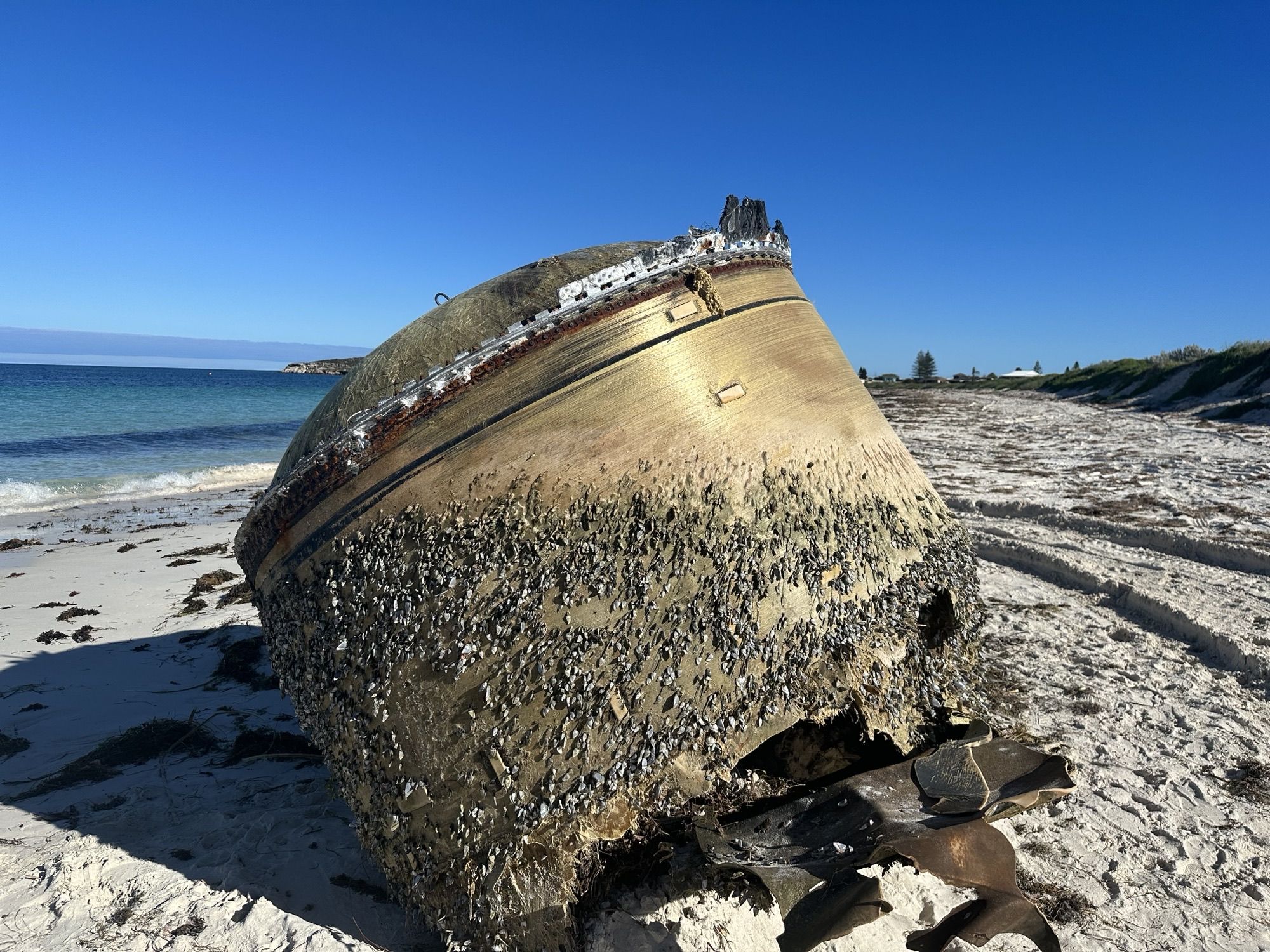Scientists Solve Mystery of Unidentified Space Object Washed up on Beach
The conundrum of an 8-foot-wide metal cylinder that was found washed up on a beach in Australia earlier this month has now been solved.
The object, which was found around 150 miles north of Perth, was initially suggested to be from an Indian rocket dating back several decades.
Now, the Australian Space Agency has said that the cylinder is most likely debris from the third stage of a polar satellite launch vehicle operated by the Indian Space Research Organisation.
The cylinder washed up on the beach in Western Australia. The object has now been identified as debris from the third stage of a polar satellite launch vehicle operated by the Indian Space Research Organisation. Australian Space Agency
"The Australian Space Agency has concluded the object located on a beach near Jurien Bay in Western Australia is most likely debris from an expended third-stage of a Polar Satellite Launch Vehicle (PSLV)," the Australian Space Agency told Newsweek in a statement sent via email.
"The PSLV is a medium-lift launch vehicle operated by the Indian Space Research Organisation (ISRO)," the statement added.
Rockets often have several "stages", each with its own engine and fuel, designed to best get the payload into orbit or beyond. Usually, the first stage is the largest, with each successive one decreasing in size. These others are jettisoned once their fuel has been expended, being released into orbit or to fall back into the atmosphere, usually burning up.
A rocket from NASA's Artemis program. These often have several "stages", each with its own engine and fuel. ISTOCK / GETTY IMAGES PLUS
"The part we have is mostly the fuel containment vessel," Alice Gorman, an expert in the field of space archaeology at Flinders University, Australia, told local media ABC Australia. "The third stage [of the rocket] ignites, burns until that fuel is gone, and the fourth stage is the one that actually gets into Earth orbit.
"Statistically speaking, it's probably a bit of a miracle that we have had so few collisions with people or animals or property on land," Gorman said.
There are numerous pieces of space debris in orbit around the Earth from our decades of space launches. The European Space Agency estimates that as of June 6, there are about 36,500 pieces of space debris greater than 3.9 inches across; around 1 million pieces between 0.4 inches and 4 inches; and more than 130 million between 0.04 and 0.4 inches across.
"More than 15,000 satellites have been placed in Earth orbit since the first satellite, Sputnik 1, was orbited by the Soviet Union on October 4, 1957. That satellite re-entered after only three months," Mark Rigby previously told Newsweek. He is an adjunct research fellow for the Centre of Astrophysics at the University of Southern Queensland in Australia and past curator of the Sir Thomas Brisbane Planetarium in Brisbane, Australia. "The number of satellites in Earth orbit has increased dramatically in recent years, due mainly to SpaceX and its Starlink communications satellites in Low Earth Orbit—now nearing 4,000."
Space junk in orbit around Earth. The European Space Agency estimates that as of June 6, there are about 36,500 pieces of space debris greater than 3.9 inches across. ISTOCK / GETTY IMAGES PLUS
Usually, when space junk falls to Earth, it burns up in the atmosphere due to the intense heat generated via friction with the atmosphere. Fuel tanks, however, are often hardier to high temperatures, which is why this third stage has survived the fall back to Earth.
Due to the large areas of the planet that are covered in ocean or uninhabited, the likelihood of a chunk of space debris like this hitting a population center is thankfully minuscule.
"While the chances are still very good that the remains will land in the ocean, there is a non-zero chance of the debris striking somewhere on the ground," Wendy N. Whitman Cobb, a professor of strategy and security studies at Air University, previously told Newsweek. "When Skylab, the U.S.'s first space-station program, was deorbited, some of its debris landed in Australia. More recently, some parts of SpaceX's Falcon 9 rockets have been found in Brazil. So, while there isn't a high chance of debris striking people or property, it's not completely absent either."
The Australian Space Agency will keep the cylinder until it figures out a plan with ISRO regarding the object's fate.
We have concluded the object located on a beach near Jurien Bay in Western Australia is most likely debris from an expended third-stage of a Polar Satellite Launch Vehicle (PSLV).
The PSLV is a medium-lift launch vehicle operated by @isro.
[More in comments] pic.twitter.com/ivF9Je1Qqy — Australian Space Agency (@AusSpaceAgency) July 31, 2023
"The debris remains in storage, and the Australian Space Agency is working with ISRO, who will provide further confirmation to determine next steps, including considering obligations under the United Nations space treaties," the Australian Space Agency said in the statement.
"The Australian Space Agency is committed to the long-term sustainability of outer space activities, including debris mitigation, and continues to highlight this on the international stage," the statement added.
It is still unclear if the ISRO will come and collect the object, or if it will be left in Australia, perhaps in a museum.
"The ISRO might decide to send a team out to Australia to look at the location and look at the actual rocket itself... or they may decide to actually leave it in Australia," Gorman said. "India is responsible under the United Nations' space treaties for any damage or costs associated with space debris that comes down, but it owns it and can decide what happens to it.
"It could be that the cost of [leaving it in Australia] is less than the cost of shipping or investigating," Gorman added.
Do you have a science story to share with Newsweek? Do you have a question about space debris? Let us know via science@newsweek.com
Source: Newsweek


